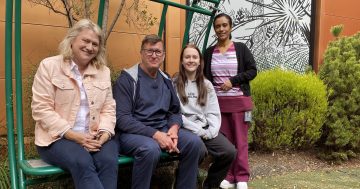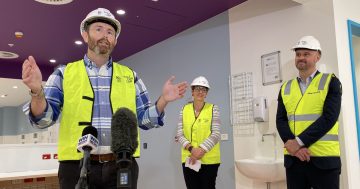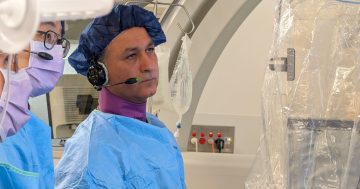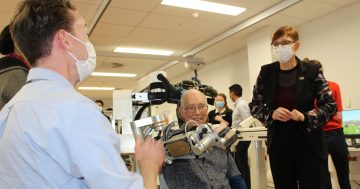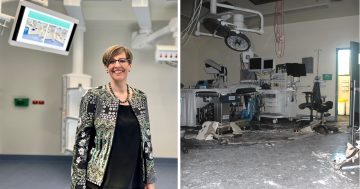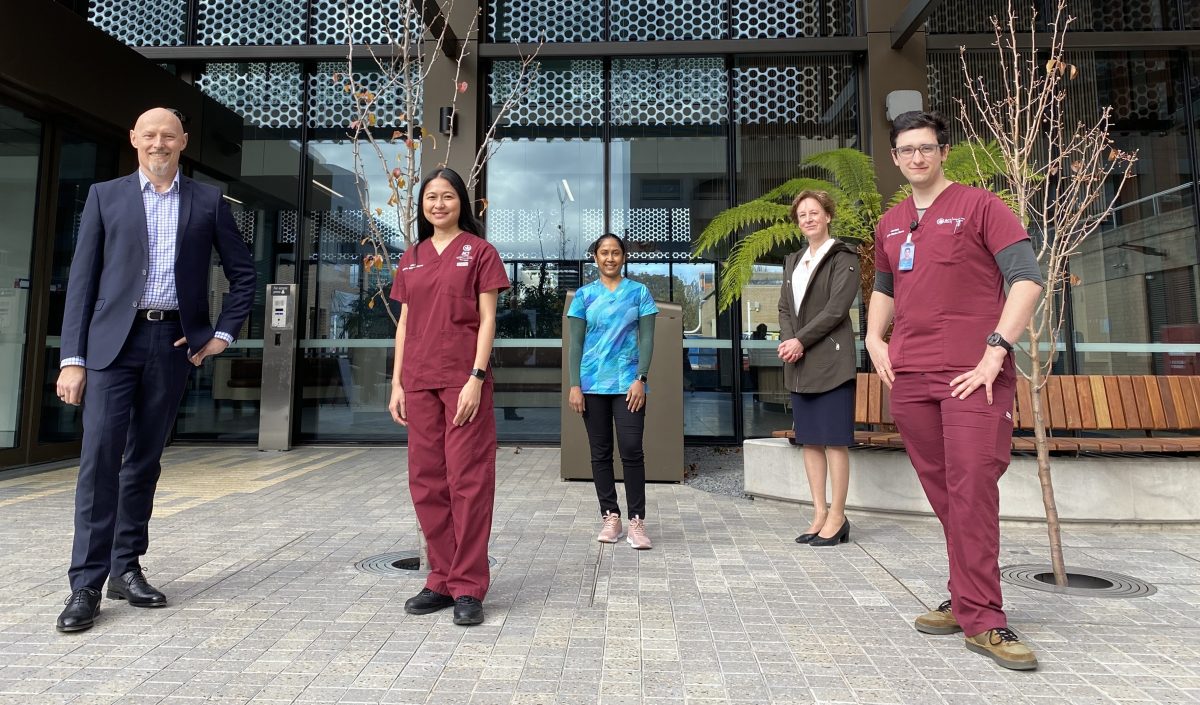
Neurologist Dr Bartlomiej Piechowski-Jozwiak, acute stroke nurse Mary Doncillo, angio clinical nurse coordinator Marilyn Manoharan, emergency staff specialist Dr Betty Domazet and stroke nurse navigator Joschka Strahan are just some of the people who are part of Canberra Hospital’s gold-standard stroke treatment team. Photo: Claire Fenwicke.
It’s called the “golden period”: the time in which a stroke sufferer needs to receive treatment to help prevent millions of brain neurons dying.
It’s a process the Canberra Hospital has spent the past six-and-a-half years finessing. Now it’s been awarded Gold Status from the World Stroke Organisation, providing assurance that Canberrans and those from the surrounding regions have access to world-class stroke treatment.
Emergency staff specialist and stroke lead Dr Betty Domazet said departments across the hospital system, in the ACT and NSW, ambulance and helicopter services had been tweaking their methods to deliver treatments as quickly as possible.
“The message is: time is brain. Every minute you waste, you’re losing more and more neurons,” she said.
“There’s multiple cogs in this wheel that all need to be aligned very well to get the patient through the system as quickly as possible and as safely as possible to see if they’re eligible for these newer treatment options.”
When stroke patients arrive at the hospital, the team aims to bypass as many waiting processes as possible to get the person into a CT scanner.
This can determine whether a person is eligible for clot busting medications (thrombolysis) and/or endovascular clot retrieval (ECR) surgery.
It’s a process that usually involves emergency department staff, radiologists, neurologists, anaesthetists, acute stroke nurses and more.
“A huge number of people get involved with just one stroke patient,” Dr Domazet said.
“We’ve been very lucky here that every department realises time is brain, and if we have every department making sure that they’re doing things as quickly and as safely as possible, then we end up with great results.”
Department of Neurology unit director Dr Bartlomiej Piechowski-Jozwiak has been part of the process for the past six months.
He said the gold status recognition showed the incredible effort of staff spread across the system working together as seamlessly as possible.
“Basically, we need to determine the eligibility for hyperacute stroke management as soon as possible … it may seem like that’s a lot of time, but it’s not,” Dr Piechowski-Jozwiak said.
“We really need to make the complex process smooth and reproducible, be it during the day, at night, on the weekend or Christmas Day.”
To get technical, there’s a national target to give a patient thrombolysis treatment with a median time of 60 minutes. For ECT, that needs to be given within 90 minutes from the time a person presents to the emergency department with a stroke.
He particularly credited the acute stroke nursing team for the work they do overseeing a patient’s various pathways through the system and making sure they get the care they need as quickly and safely as possible.
“They are critical in responding to the stroke alert.”
Acute stroke nurse Manju John has been part of the program since its inception and said she was especially proud of her team’s work during the “golden period” of a stroke – the time between presentation and getting a CT scan (which determines treatment).
“Our role is to improve that time, that is the critical timing for us in order for the treatment to be beneficial,” she said.
“Millions of neurons are dying within seconds … they don’t regenerate, so this is preventing that disabling of the patient.”
But Dr Piechowski-Jozwiak said achieving gold status was just the beginning of the program’s “quality and safety” journey.
He said more staff and investment in training would achieve even higher standards and patient outcomes for the region.
More emphasis on preventing non-communicable diseases (NCDs) such as stroke in the first place is also an area he’s passionate about.
“We’re very happy to help, but this is fixing a problem when it occurs … but every ambulance coming into emergency is a missed opportunity for prevention in the first place,” Dr Piechowski-Jozwiak said.
“It’s very frustrating especially seeing young people present with stroke, who can become disabled or even not survive … we need to expand efforts to prevention and identifying risk factors of NCDs, as up to 80 per cent are preventable.
“It is critical to expand national targets into this health and prevention space to increase the health and life span of our communities.”














